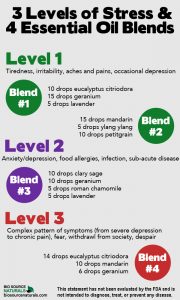Stress and Essential Oils
Stress and Essential Oils

Stress and essential oils go well together, as they work to help physical issues, like strengthening the immune system and reducing aches and pains.* But they also help the negative emotional and mental consequences of stress, such as simple irritability and moodiness, to depression and anxiety.*
It’s important to know the more common symptoms of stress so you can identify them in yourself or someone you care about. Being able to identify symptoms such as fatigue, sleep problems, upset stomach, angry outbursts, muscle tension, headaches, and sadness, to name a few, is helpful. You can then begin to manage your stress (or have a talk with your loved one to determine what’s wrong).
Our chart, above, divides stress into 3 levels, starting with minor stress at Level 1, and severe stress at Level 3. Essential oils for each particular type of stress are identified, along with blends you can make yourself.* Use any of these oils alone, or in one of the recommended blends.
Use these blends (or any individual oils) in a diffuser or your bath. If using the blends or individual oils for a massage, be sure to mix them with a carrier oil as your base. See below for a repeat of what is summarized in the chart.
Stress and Essential Oils
Stress Level One
Tiredness, irritability, aches and pains, occasional depression
Stress Level One Blend 1
10 drops eucalyptus citriodora
15 drops geranium
5 drops lavender
Stress Level One Blend 2
15 drops tangerine
5 drops ylang ylang
10 drops petitgrain
Stress Level Two
Anxiety/depression, food allergies, infection, sub-acute disease
Stress Level Two Blend
10 drops clary sage
10 drops geranium
5 drops roman chamomile
5 drops lavender
Stress Level Three
Complex pattern of symptoms (anything from severe depression to chronic pain), fear, withdrawal from society, despair
Stress Level Three Blend
14 drops eucalyptus citriodora
10 drops tangerine
6 drops geranium
Source
Worwood, Valerie Ann, The Fragrant Mind, New World Library, 1996
